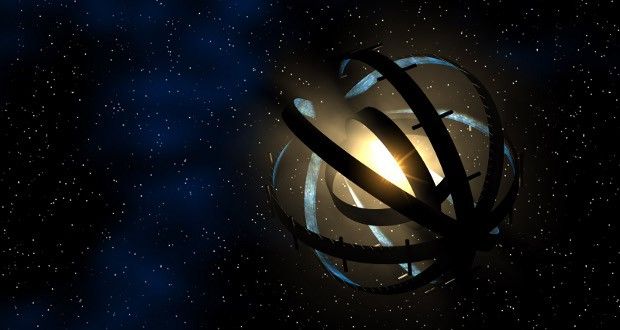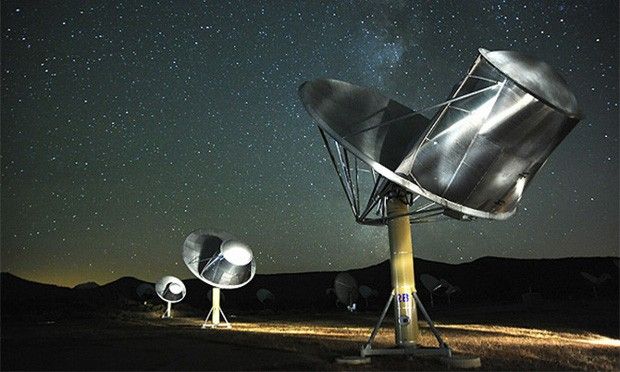It's happening, folks. Scientists are officially scouting for signs of alien lifeforms that could be thriving somewhere near a star about 1,500 light-years away, and they might, in fact, be on to something.
Even cooler, they're not looking for extraterrestrials microbes or other teeny tiny creatures that are just now starting to figure out what's what. Au contraire, what they expect might be lurking near this star that's sparked their interest is an advanced, super intelligent alien civilization.
The kind of alien civilization that's technologically advanced enough to have built a gargantuan sphere around the fiery orb just to suck up its energy and use it as a power source, to be more precise.
How this hunt for aliens got started
Last week, astronomers announced the discovery of a bizarre-acting star, KIC 8462852, which for some reason displays notable and rather inexplicable fluctuations in the light it emits.
You see, regular stars like our Sun are creatures of habit. They are each characterized by a specific luminous output and they stick to it throughout their entire life. Sure, they tend to act out when nearing their demise, but other than this, their behavior is fairly predictable.
KIC 8462852, however, likes to play the cosmic traffic light. Sometimes it's super bright, sometimes it's oddly dim. From afar, it kind of looks like somebody keeps flicking it on and off.
“KIC 8462852 was observed to undergo irregularly shaped, aperiodic dips in flux down to below the 20% level,” astronomers explain this confusing star's peculiar routine in a recent paper. “The dipping activity can last for between 5 and 80 days,” they go on to detail.
Scientists say the more reasonable explanation for these shifts in the orb's luminosity is an army of comets that, as they circle the star and sometimes get too close to it, get pulverized and so produce massive amounts of debris. In turn, this debris dims KIC 8462852.
Still, they're not denying there is one other possible explanation: aliens. A mammoth sphere built around the star by an alien civilization and designed to harvest the orb's energy, that is.
Wait, what?
Such humongous spheres first came up in 1937, when British philosopher and author William Olaf Stapledon described them in his science fiction novel “Star Maker.” Then, the concept was more widely discussed by American theoretical physicist and mathematician Freeman John Dyson in 1960.
Now known as Dyson spheres, such structures are high-tech globes big enough to encompass a star in its entirety, essentially swallowing it. With a star nestled inside them, the structures could them proceed to harvest its energy and deliver it to whatever civilization had built them and put them to work.
When he discussed the concept gargantuan structures in 1960, Freeman John Dyson argued that they would make the best possible power source for highly developed and technologically advanced civilizations. He also said that the quest for alien civilizations should focus on locating such spheres.
Scientists are finally taking his advice
This Thursday, researchers with the SETI (Search for Extraterrestrial Intelligence) Institute published their own report proposing that, given KIC 8462852's inexplicable shifts in brightness, the star might, in fact, be cocooned by a Dyson sphere built by an advanced alien civilization.
Hence, on October 16, the scientists officially started researching the star and its surroundings in the hope that they might detect signs of aliens thriving in this corner of the universe.
The team admit the luminosity glitches might come down to debris obscuring the orb from sight every now and again, but they say the possibility of finding alien life is simply too tantalizing to just let this opportunity slip by and brush off KIC 8462852's odd behavior as pure mishaps.
“KIC 846 2852 is different, because the evidence suggesting astroengineering is direct - there's a clear-cut and periodic dimming of the starlight,” the researchers write in their report.
“Given this intriguing behavior, shouldn't we be checking out this star more carefully? Isn't it possible that this is a home to true cosmic intelligence - not just pond scum in the watery recesses of a nearby world, but technically adept beings who might have something interesting to tell us?”
The scientists are studying the star with the help of the Allen Telescope Array at the Hat Creek Radio Observatory in California. Since the investigation has only just begun, they don't have much to tell us. Still, they promise to update us as soon as they find something worthwhile.
The bad news
While KIC 8462852's behavior does hint at the presence of a structure encircling it, the odds don't seem to be in favor of any extraterrestrial beings that might have evolved in this part of the cosmos.
For one thing, the star is about one and a half times as big as our Sun, five times as bright and super hot. Scientists say this means it emits vast amounts of ultraviolet light, which would in turn almost surely make any orbiting planet inhospitable.
“A few thousand degrees hotter than the Sun, this star would bleach the surface of any encircling planet with highly unfriendly ultraviolet light,” the SETI Institute researchers themselves admit.
Then, as young as the star might now be, the fact of the matter is that it has a life expectancy of just 3 billion years. Here on Earth, it took over 4 billion years for life to evolve to its current technological level, which isn't even all that advanced.
What this means is that, for an advanced alien civilization to the hiding near KIC 8462852, it would have had to develop and evolve at a staggering pace. Nobody is saying that something like this couldn't have happened, but the chances are pretty slim.

 14 DAY TRIAL //
14 DAY TRIAL // 



